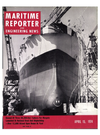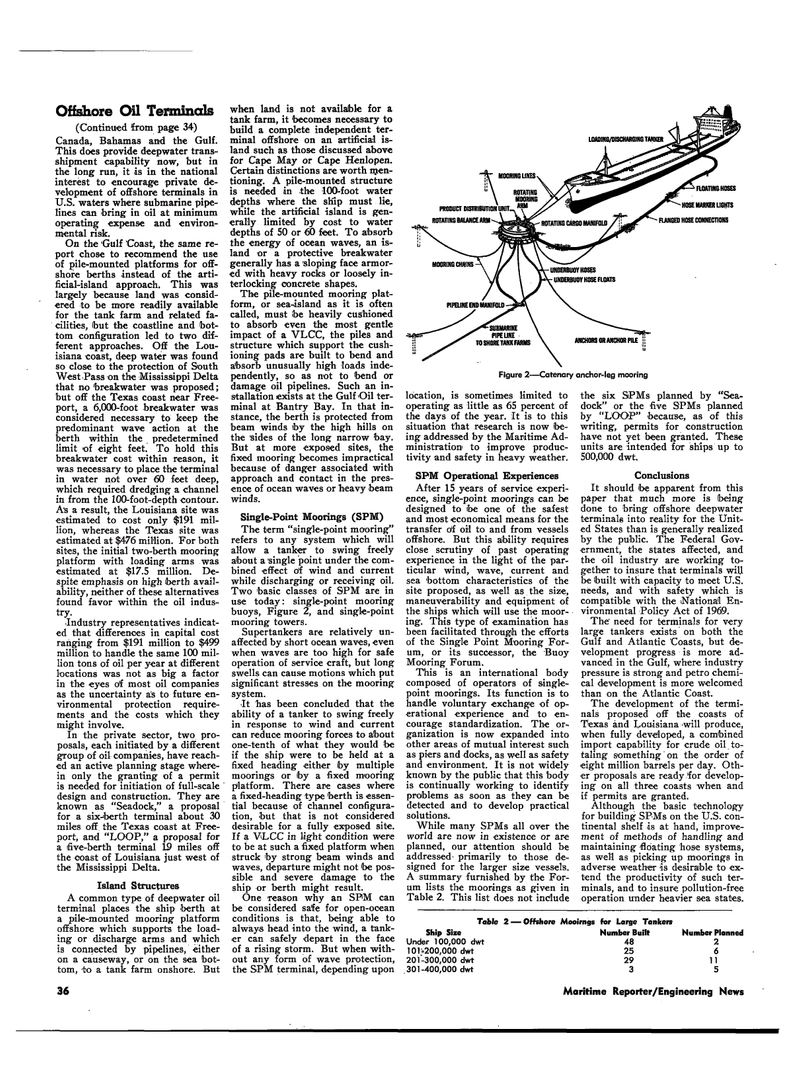
Page 33: of Maritime Reporter Magazine (April 15, 1974)
Read this page in Pdf, Flash or Html5 edition of April 15, 1974 Maritime Reporter Magazine
Figure 2—Catenary anchor-leg mooring
Offshore Oil Terminals (Continued from page 34)
Canada, Bahamas and the Gulf.
This does provide deepwater trans- shipment capability now, but in the long run, it is in the national interest to encourage private de- velopment of offshore terminals in
U.S. waters where submarine pipe- lines can bring in oil at minimum operating expense and environ- mental risk.
On the Gulf Coast, the same re- port chose to recommend the use of pile-mounted platforms for off- shore berths instead of the arti- ficial-island approach. This was largely because land was consid- ered to be more readily available for the tank farm and related fa- cilities, but the coastline and bot- tom configuration led to two dif- ferent approaches. Off the Lou- isiana coast, deep water was found so close to the protection of South
West Pass on the Mississippi Delta that no "breakwater was proposed; but off the Texas coast near Free- port, a 6,000-foot breakwater was considered necessary to keep the predominant wave action at the berth within the predetermined limit of eight feet. To hold this breakwater cost within reason, it was necessary to place the terminal in water not over 60 feet deep, which required dredging a channel in from the 100-foot-depth contour.
A's a result, the Louisiana site was estimated to cost only $191 mil- lion, whereas the Texas site was estimated at $476 million. For both sites, the initial two-berth mooring platform with loading arms was estimated at $17.5 million. De- spite emphasis on high berth avail- ability, neither of these alternatives found favor within the oil indus- try. •Industry representatives indicat- ed that differences in capital cost ranging from $191 million to $499 million to handle the same 100 mil- lion tons of oil per year at different locations was not as big a factor in the eyes of most oil companies as the uncertainty a's to future en- vironmental protection require- ments and the costs which they might involve.
In the private sector, two pro- posals, each initiated by a different group of oil companies, have reach- ed an active planning stage where- in only the granting of a permit is needed for initiation of full-scale design and construction. They are known as "Seadock," a proposal for a six-berth terminal about 30 miles off the Texas coast at Free- port, and "LOOP," a proposal for a five-berth terminal IS miles off the coast of Louisiana just west of the Mississippi Delta.
Island Structures
A common type of deepwater oil terminal places the ship berth at a pile-mounted mooring platform offshore which supports the load- ing or discharge arms and which is connected by pipelines, either on a causeway, or on the sea bot- tom, to a tank farm onshore. But when land is not available for a tank farm, it 'becomes necessary to build a complete independent ter- minal offshore on an artificial is- land such as those discussed above for Cape May or Cape Henlopen.
Certain distinctions are worth men- tioning. A pile-mounted structure is needed an the 100-foot water depths where the ship must lie, while the artificial island is gen- erally limited by cost to water depths of SO or 60 feet. To absorb the energy of ocean waves, an is- land or a protective breakwater generally has a sloping face armor- ed with heavy rocks or loosely in- terlocking concrete shapes.
The pile-mounted mooring plat- form, or sea^sland as it is often called, must be heavily cushioned to absorb even the most gentle impact of a VLCC, the piles and structure which support the cush- ioning pads are built to bend and absorb unusually high loads inde- pendently, so as not to bend OT damage oil pipelines. Such an in- stallation exists at the Gulf Oil ter- minal at Bantry Bay. In that in- stance, the berth is protected from beam winds by the high hills on the sides of the long narrow bay.
But at more exposed sites, the fixed mooring becomes impractical because of danger associated with approach and contact in the pres- ence of ocean waves or heavy beam winds.
Single-Point Moorings (SPM)
The term "single-point mooring" refers to any system which will allow a tanker to swing freely about a single point under the com- bined effect o'f wind and current while discharging or receiving oil.
Two basic classes of SPM are in use today: single-point mooring buoys, Figure 2, and single-point mooring towers.
Supertankers are relatively un- affected by short ocean waves, even when waves are too high for safe operation of service craft, but long swells can cause motions which put significant stresses on the mooring system.
It has been concluded that the ability of a tanker to swing freely in response to wind and current can reduce mooring forces to about one-tenth of what they would be if the ship were to be held at a fixed heading either by multiple moorings or by a fixed mooring platform. There are cases where a fixed-heading type 'berth is essen- tial because of channel configura- tion, but that is not considered desirable for a fully exposed site.
If a V-LCC in light condition were to be at such a fixed platform when struck by strong beam winds and waves, departure might not 'be pos- sible and severe damage to the ship or berth might result.
One reason why an SPM can be considered safe for open-ocean conditions is that, being able to always head into the wind, a tank- er can safely depart in the face of a rising storm. But when with- out any form of wave protection, the SPM terminal, depending upon u location, is sometimes limited to operating as little as 65 percent of the days of the year. It is to this situation that research is now be- ing addressed by the Maritime Ad- ministration to improve produc- tivity and safety in heavy weather.
SPM Operational Experiences
After 15 years of service experi- ence, single-point moorings can be designed to be one of the safest and most economical means for the transfer of oil to and from vessels offshore. But this ability requires close scrutiny of past operating experience in the light of the par- ticular wind, wave, current and sea bottom characteristics of the site proposed, as well as the size, maneuverability and equipment of the ships which will use the moor- ing. This type of examination has been facilitated through the efforts of the Single Point Mooring For- um, or its successor, the Buoy
Mooring Forum.
This is an international body composed of operators of single- point moorings. Its function is to handle voluntary exchange of op- erational experience and to en- courage standardization. The or- ganization is now expanded into other areas of mutual interest such as piers and docks, as well as safety and environment. It is not widely known by the public that this body is continually working to identify problems as soon as they can be detected and to develop practical solutions.
While many SPMs all over the world are now in existence or are planned, our attention should be addressed- primarily to those de- signed for the larger size vessels.
A summary furnished by the For- um lists the moorings as given in
Table 2. This list does not include the six SPMs planned by "Sea- dock" or the five SPMs planned by "LOOP" because, as of this writing, permits for construction have not yet been granted. These units are intended for ships up to 500,000 dwt.
Conclusions
It should be apparent from this paper that much more is 'being done to bring offshore deepwater terminals into reality for the Unit- ed States than is generally realized by the public. The Federal Gov- ernment, the states affected, and the oil industry are working to- gether to insure that terminals will be built with capacity to meet U.S. needs, and with safety which is compatible with the National En- vironmental Policy Act of 1969.
The' need for terminals for very large tankers exists on both the
Gulf and Atlantic Coasts, but de- velopment progress is more ad- vanced in the Gulf, where industry pressure is strong and petro chemi- cal development is more welcomed than on the Atlantic Coast.
The development of the termi- nals proposed off the coasts of
Texas and Louisiana will produce, when fully developed, a combined import capability for crude oil to- taling something on the order of eight million barrels per day. Oth- er proposals are ready 'for develop- ing on all three coasts when and if permits are granted.
Although the basic technology for building SPMs on the U.S. con- tinental shelf is at hand, improve- ment of methods of handling and maintaining floating hose systems, as well as picking up moorings in adverse weather is desirable to ex- tend the productivity of such ter- minals, and to insure pollution-free operation under heavier sea states.
Table 2 — Offshore Mooimgs for Large Tankers
Ship Size Number Built Number Planned
Under 100,000 dwt 48 2 101-200,000 dwt 25 6 201-300,000 dwt 9 11 301-400,000 dwt 3 5 36 Maritime Reporter/Engineering News

 32
32

 34
34
